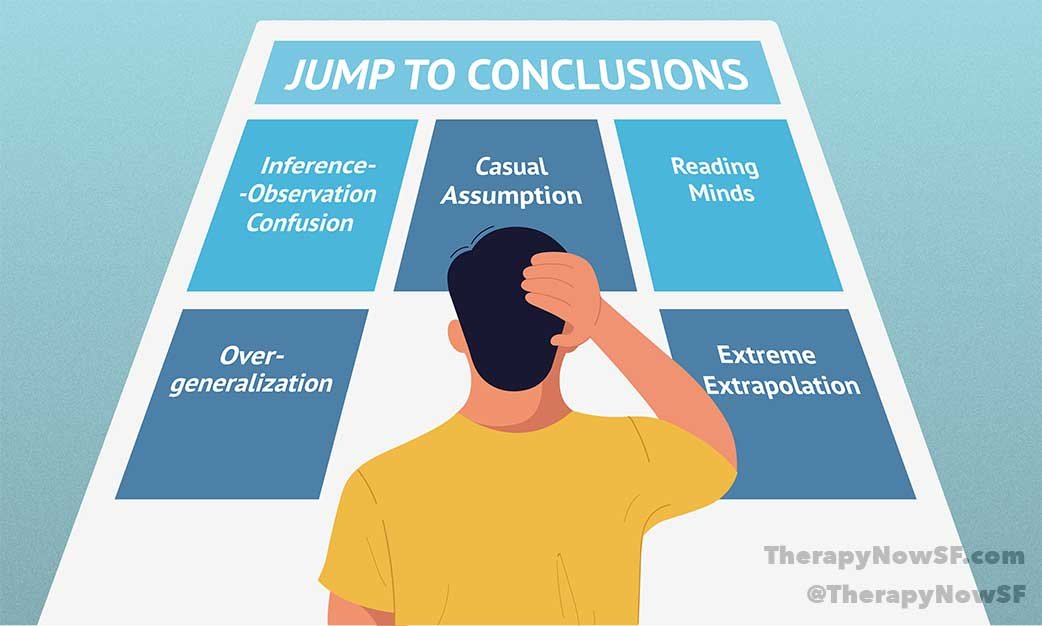Jumping to Conclusions: Learn How to Stop Making Anxiety-Fueled Mental Leaps
We have all done it before. Someone is telling us a story and we forge ahead, jumping to a conclusion. It may or may not be correct, but we’re convinced that we know the outcome.
In cognitive behavioral therapy, jumping to conclusions is a symptom of an underlying condition, such as panic disorder, anxiety or depression. It is intrinsically tied to negative thinking patterns, similar to overgeneralization and related cognitive distortions.
What Is Jumping to Conclusions?
Jumping to a conclusion is a phrase used to describe a situation in which someone leaps to a conclusion without sufficient information to justify it. There are many different ways people jump to conclusions, as well, including the following:
Inference-Observation Confusion: In this situation, you infer something using logic, but mistake it for something that you observed physically. For instance, seeing someone wearing flashy jewelry and believing that person is very wealthy. The truth is that you simply observed them wearing jewelry, which made you believe that the person is wealthy.
Casual Assumption: People rely on intuition, but it can lead to mistakes. For instance, you might assume that because someone is not smiling while you speak to them, they are angry at you, when in truth they are preoccupied with something else and their lack of a smile has nothing to do with you, personally.
Reading Minds: Here, we assume that we know what someone else is thinking, usually in a negative sense, and generally tied to how they have acted in our presence. For example, if someone does not say reply when you say good morning, you might assume that they are thinking that they dislike you.
Overgeneralization: Overgeneralization is often recognized as a cognitive distortion in its own right, but it can also play a role in jumping to conclusions. Here, you assume that because you experienced negative results from an action once, you will always experience negative results from that action. It is often accompanied by thoughts like “I can’t do anything right”, or feeling that no one likes you.
Extreme Extrapolation: This one is similar to overgeneralization, and it involves taking a minor incident and extrapolating something major (and negative) from it. This is often worst-case scenario thinking.
Fortune Telling: This form of jumping to conclusions means assuming you’ll know what is going to happen in the future. Someone who is fortune telling might assume they’re going to do a bad job on a project at work before they ever start.
Labeling: Labeling means that someone makes assumptions about others based on opinions or behaviors stereotypically associated with a group they are not a part of. For instance, someone who engages in labeling might assume that their female friend doesn’t enjoy video games since they assume only men play games.
Keep in mind that overlap can be involved between types of jumping to conclusions. As an example, labeling is a form of overgeneralizing, and several forms of jumping to conclusions are also types of casual assumptions.
Examples of Jumping to Conclusions
To get a better understanding of how jumping to conclusions works, looking at a few examples of this way of thinking can help. Below are a few of the ways that someone might experience jumping to conclusions:
Yoshi sends a text message to Carrie after a great first date. When she doesn’t instantly respond, he assumes she is no longer interested in seeing him.
Dan has trouble with math and has an exam coming up. He assumes he’ll do terribly. That leads to him not studying since it seems there’s no point.
Anyta walks into the office and her boss doesn’t smile at her. She assumes he is mad at her about something. She spends the morning thinking about what she might have done wrong.
Emma is in front of several colleagues when she has a panic attack. She believes everyone who sees it will think badly of her due to having anxiety. She’s sure her boss will fire her if they find out about her anxiety.
In all of these examples, someone is jumping to conclusions. All the people assume that they know what is going to happen in the future or what other people are thinking about a situation.
How to Stop Jumping to Conclusions
While we all jump to conclusions from to time, for some of us, it is a set pattern of behavior, often tied to anxiety or panic disorder. However, there are ways to stop jumping to conclusions.
Remember When You Were Wrong: One tip is to remember times when you jumped to the wrong conclusion. Could this one be similar?
Slow Down and Think: Instead of going with whatever your immediate assumption is, stop yourself. Take time to consider the situation before you come to a conclusion.
Consider the Facts: Before coming to a conclusion, make sure you get all the information you can find. This lets you consider a variety of factors before you make a decision or judge something.
The Whole Picture: Do you see the whole picture? Do you have all the information to make an informed decision?
Challenge Your Thinking: If you notice you are making assumptions, spend a moment challenging whatever conclusions came to you. Would there be some other explanation that would also fit?
Ask Questions: When you find yourself making assumptions about someone else and what they think, practice simply asking them. Communicating to get an answer will prevent some of your confusion.
Check the Evidence: What evidence do you have to support the conclusion you’re drawing? Are your thoughts based on facts or feelings?
Step in Someone Else’s Shoes: Put yourself in someone else’s shoes and think about the conclusions they might draw. How would they interpret things? What information would they need to get the right conclusion?
Jumping to conclusions can lead to negative situations and thoughts. It is important to stop, think things through, and then make an informed decision. It is also important to treat the underlying panic, depression or anxiety disorder that leads to this type of pattern.

